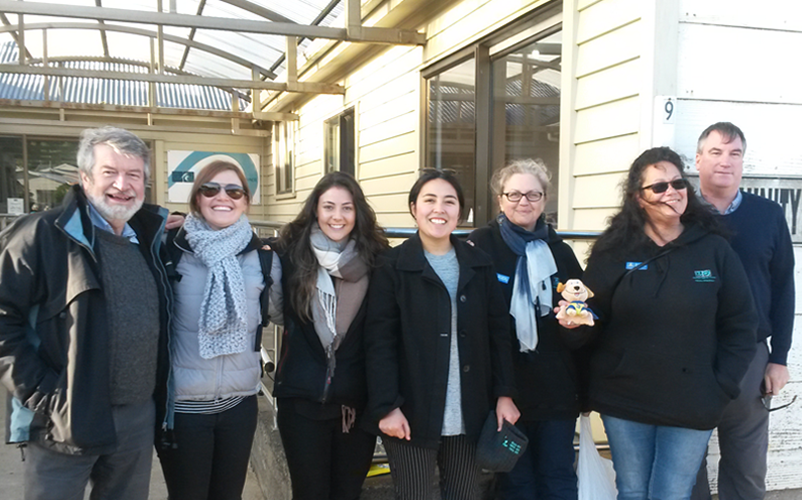On 15 August 1868, a great earthquake struck off the coast of the Chile-Peru border generating a tsunami that travelled across the Pacific Ocean. Wharekauri-Rēkohu-The Chatham Islands, located 800 km east of Christchurch city, was one of the worst affected locations in Aotearoa-New Zealand. Tsunami waves, including three over six metres high, injured and killed people, destroyed buildings and infrastructure and affected the environment, economy and communities. Advancements in disaster risk reduction systems and technology have significantly advanced since then, as has Aotearoa-New Zealand’s capacity to be ready for and respond to earthquakes and tsunami. However, collective memory of this event and other tsunami events has diminished. In 2018, a team of scientists, emergency managers and communication specialists collaborated to organise a memorial event on the Chatham Islands and coordinate a multi-agency media campaign to commemorate the 150th anniversary of the 1868 Arica tsunami. This paper describes the purpose and variety of contexts in which anniversary memorial events are held. The 1868 Arica tsunami event and the design and components of the 150th anniversary memorial event are examined to detail the educative function this memorial held and potential improvements for future memorial events. The importance of commemorating centennial disaster anniversaries using memorial events is highlighted as it raises awareness and increases community preparedness for future events: ‘lest we forget and let us learn’.
Introduction
Anniversaries of disaster events are a time when people’s memories and personal experiences are powerfully evoked, prompting recollection, reflection and storytelling (Forrest 1993, Echterling 1998). Disaster memorials, including permanent features such as plaques, gardens, art and statues as well as services and events are ‘symbolic forms of ritual expression demonstrating the impact of tragedy, particularly sudden and unexpected events, on communities’ (Eyre 1999, p.23).
Memorial events held within the weeks, months or years following a disaster may play a crucial role in community recovery and encourage community resilience (Eyre 2007, 1999; Nicholls 2006). Eyre (1999) explained that both informal (impromptu, community-led initiatives such as flower laying) and formal (organised events) anniversary memorials allow collective expression of grief. This is an important process for some people to come to terms with tragedy and seek comfort and is part of the healing process. However, for some people, these memorials may cause trauma and reduce community resilience (Garde-Hansen et al. 2017, Fraser 2018, McKinnon 2019). This can occur when memorials place the event in the past and put pressure on people to forget, downplay the effects, are not inclusive of marginalised groups, are not carried out in a culturally appropriate manner or do not appropriately address failed disaster management policies (McKinnon 2019, Fraser 2018).
This paper describes the memorial event held to commemorate a 150th anniversary, which held a different purpose or kaupapa1. Anniversaries in longer timeframes after disaster events, where people have not been directly affected, can have a educative function greater than those held in the immediate aftermath. These memorials raise awareness of past events that may have diminished in a community’s collective memory (defined by Roediger & Abel (2015) as recollections of events shared by a group). Memorials also reflect on the lessons learnt and encourage preparedness for future events (Blanchard-Boehm & Cook 2004; Cowan, McClure & Wilson 2002; McGee & Young 2000; Blanchard-Boehm 1996).
Aotearoa-New Zealand’s disaster risk reduction agencies, including the National Emergency Management Agency, regional Civil Defence Emergency Management groups and operational monitoring agencies such as the MetService and GeoNet use websites and social media channels to acknowledge and publicise historical disaster anniversaries (Hill 2016). However, memorial events for events of decades or centuries ago are rare. Examples include the 85th anniversary of the Hawkes Bay earthquake in 2016 and the 50th anniversary of the Īnangahua earthquake in May 2018 (Laing 2016). Prior to 2018, memorial events were not held to commemorate historical tsunamis.
The 15 August 2018 marked the 150th anniversary of the 1868 Arica earthquake and tsunami. While Aotearoa-New Zealand’s tsunami exposure is widely documented, there has been less focus on the Chatham Islands, located 800 km east of Christchurch (Figure 1). The Chatham Islands are exposed to tsunami from all sides and was one of the most affected locations during this event. Since then, no tsunami has been as destructive and tsunamis have not caused damage to the Chatham Islands since 1960. As a result, some members of the community have grown complacent (Thomas 2018).
This study received approval from Massey University, Ethics Notification Number 4000019934.
The 1868 Arica tsunami
On August 14 1868 at 10:15 am (Chatham Islands local date and time), a large-magnitude earthquake struck off the coast of Arica, near the Chile-Peru border. The earthquake generated a large tsunami that was observed throughout the Pacific region (Figure 2). As no tsunami warning system existed for the Pacific at that time, people in areas beyond the earthquake source were generally caught unaware. Almost 15 hours after the earthquake, at 1:00 am on 15 August, an hour before high tide, the largest tsunami waves arrived along the east and north coasts (Downes et al. 2017, McSaveney 2006, North Otago Times 1868). People woke to a loud roar and water surging through their homes. Ten minutes later, a larger wave hit followed 3–5 minutes later by a third large wave that dragged away everything still standing (Wanganui Herald 1868, Downes et al. 2017, Hawkes Bay Herald 1868).
…the first great wave rushed in with such force and terrific noise that the very foundation of the deep seemed broken up. In ten minutes more, another wave, more terrible than the former, commenced its work of destruction and after a like interval, the third and last completed the catastrophe. Indeed, the full wrath of the ocean seemed to battle with the island in fierce resolve to submerge it… The third wave, which came rolling in with most awful grandeur and thousand-fold power, bearing down outbuildings and stout old akeakes [native tree, Olearia traversiorum], which broke and cracked beneath its fury like matchwood, carrying away young cattle, and scattering the debris of the ruins far away…
Hawkes Bay Herald 1868
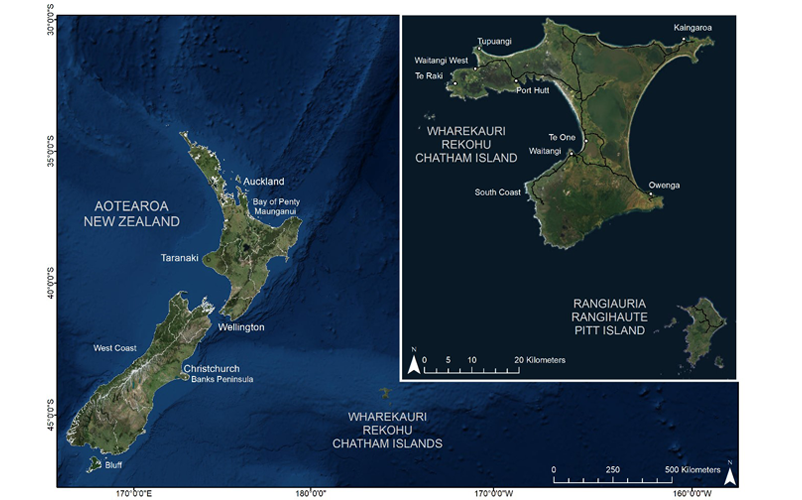
Figure 1: Location of the Chatham Islands off the east coast of Aotearoa-New Zealand. Map produced using ESRI World Imagery Basemap and Stats New Zealand Regional Council 2018 Boundaries.
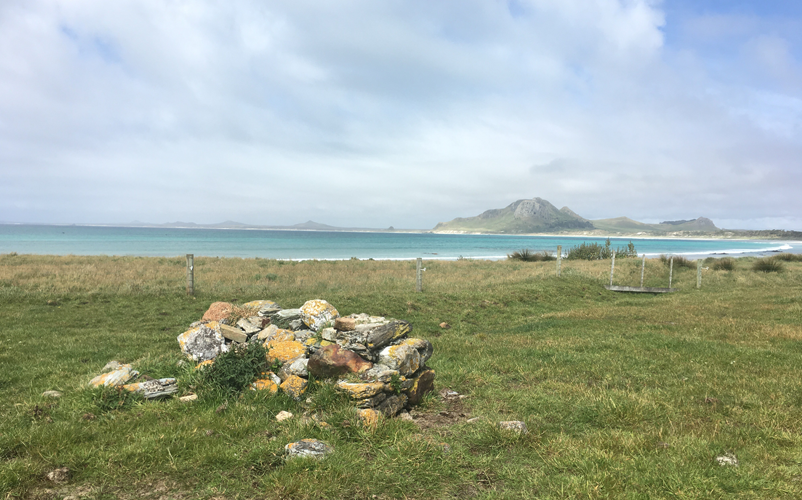
House ruins at Tupuangi from the 1868 Arica tsunami. Image: Kristie-Lee Thomas.
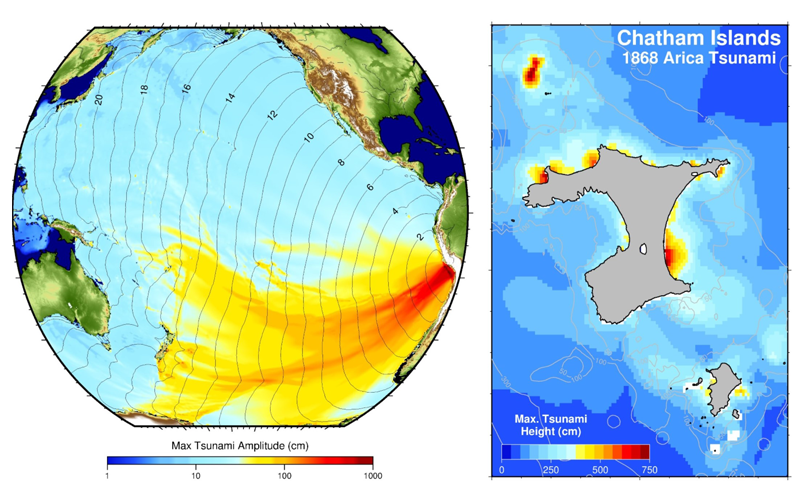
Figure 2: Trans-Pacific propagation pattern of the 1868 Arica tsunami (left) and modelled tsunami height around the Chatham Islands coastline (right). Image: Jose Borrero
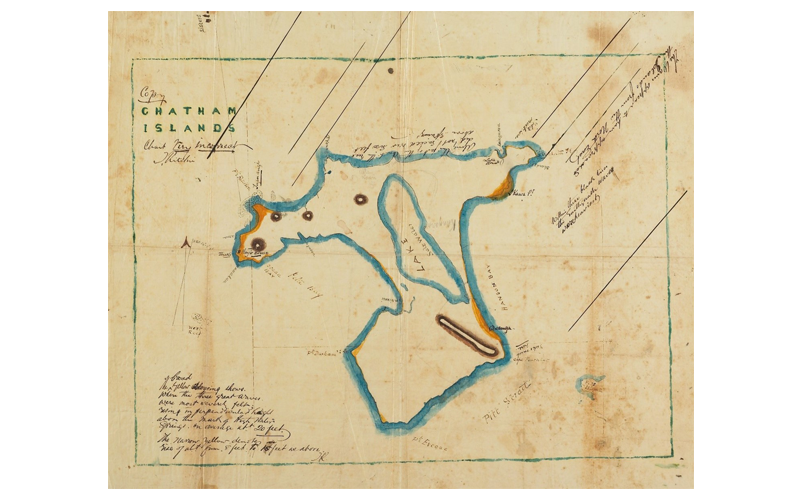
Figure 3: Map of the 1868 tsunami inundation (yellow) produced by local run holder and trader, Mr Thomas Ritchie. Image courtesy of National Museum of New Zealand Te Papa Tongarewa (1868)
The entire Chatham Islands coastline was affected (Figure 3). The north and east coasts experienced waves up to six metres that flooded up to six kilometers inland. Waitangi, Te One and the South Coast experienced waves of 2.4–4.6 metres (Hawkes Bay Herald 1868).
Tupuangi, Te Raki and Waitangi West experienced the greatest effects of the tsunami. The entire kāinga2 at Tupuangi, where approximately 70 people lived, was destroyed. Whare3 were smashed, vegetation was destroyed and sand, boulders and seaweed covered the ground (Holmes 1993; Richards, Carter & Amery 2009; Otago Witness 1868). Māori oral histories reveal three whānau4 were washed away with their whare and drowned (Thomas 2018). People who ran to high ground survived but were left with nothing. The once flourishing settlement was abandoned and many people returned to ancestral lands in Taranaki (on mainland Aotearoa-New Zealand) soon after (Holmes 1993, Lawrie & Powell 2006, Travers 1871).
The rest of the island fared little better. A man drowned at Waitangi West while trying to save a fishing boat (Otago Witness 1868, Wanganui Herald 1868). Many houses were destroyed and washed away and the Pā5 at Waitangi was damaged (North Otago Times 1868, Otago Witness 1868, Hawkes Bay Herald 1868). Boats and bridges were damaged or washed away, beaches were covered in debris and sand dunes were eroded (Otago Witness 1868; Richards, Carter & Amery 2009; Wanganui Herald 1868; Travers 1871). Abnormal waves, surges and strong currents continued over the following 24 hours even as people cleaned up the mess left behind the tsunami (Downes et al. 2017).
Tsunami waves affected Aotearoa-New Zealand one to two hours after arrival in the Chatham Islands. Several people were nearly swept away, many boats were damaged and some homes, roads and fences were destroyed, particularly around Banks Peninsula near Christchurch (Downes et al. 2017; De Lange, Healy & Geophysics 1986; Borrero & Goring 2015). In Lyttleton Harbour, the tsunami had a trough-to-peak height of around 7.6 metres (Gibson 1868). Tsunami waves and surges were observed over the next two days along the east coast from Maunganui in the north to Bluff in the south as well as in places along the West Coast region.
Memorial event and media
Research investigating the 1868 tsunami and its impacts on the Chatham Islands by Thomas (2018) and developing tsunami evacuation zones by the Chatham Islands Council provided a timely opportunity to hold a memorial event to commemorate the 150th anniversary and promote tsunami awareness and readiness. GNS Science, GeoNet and Massey University Joint Centre for Disaster Research evaluated interest from Chatham Islands Emergency Management, both indigenous groups Ngāti Mutunga o Wharekauri Iwi6 and Moriori (through their respective Iwi Trust Offices7) as well as other interested groups including the Chatham Islands Museum, two primary schools and infrastructure companies. Interest in designing and organising the event was received from the Chatham Island Emergency Management and Ngāti Mutunga o Wharekauri Iwi Trust Manager. Two primary schools on Chatham Island, Kaingaroa School and Te One School, were also interested (Pitt Island School was not contacted and will be for future engagement). Other groups indicated they may attend the memorial or were unable to contribute at the time. Phone calls and emails were exchanged to design the activities and organise the event. Invitations were extended to members of the science community invested in tsunami research on the Chatham Islands.
The agreed purpose of the campaign was to:
- raise awareness of the fatal and destructive 1868 Arica tsunami
- acknowledge and remember people who lost their lives and incurred losses from the tsunami; people on the Chatham Islands and the 25,000 who died in areas of southern Peru
- raise awareness of potential tsunami sources for Aotearoa-New Zealand and the Chatham Islands as well as tsunami processes and warning systems
- raise awareness of the potential impacts that may occur if a tsunami of similar magnitude hit the islands again and what the community can do to reduce the consequences (sharing results from recent research)
- encourage the community to be prepared for and resilient to future tsunamis.
Chatham and Pitt islands have a combined population of approximately 600 people, of which, 59 per cent identify as Māori with the remainder mostly identifying as being European or Pacific Islanders (Statistics New Zealand 2013). People known to have lost their lives in 1868 on the Chatham Islands were of Ngāti Mutunga decent (Thomas 2018). Therefore, it was vital that memorial activities be carried out in a culturally appropriate manner, abiding by Chatham Islands community tikanga8 and kawa9. This was ensured by co-designing the memorial event with local and iwi representatives.
To prepare for the event, postcard-sized flyers were created with tsunami facts and evacuation messages (Figure 4). These were co-designed with Chatham Islands Emergency Management and GeoNet as take-home resources that could be displayed in homes. The messages were consistent with National Emergency Management Agency messaging and had specific advice for the Chatham Islands community. The messages and layout also followed evacuation boards to be erected on island. The postcard was designed with local context in mind; a light-hearted image of a Weka (native bush hen, Gallirallus australis) and her chick evacuating with a kete10 was used to connect with local people as Weka are well-known on the Chatham Islands and are used as mascots of sports teams.
The anniversary was commemorated by travelling to the worst-affected site of Tupuangi to acknowledge the destruction and to say a karakia11 for the lives lost there. This was followed by kai12 (sausage sizzle) to abide by tikanga, followed by korero13 looking at how the community could be prepared for a future tsunami. Copies of a story written for the Chatham Islander newspaper, the postcards and evacuation zone maps were distributed to attendees. Copies were also left at the hotel for local people and tourists. Kaingaroa School (less than ten pupils) joined in with memorial activities. Te One School (approximately 50 students) preferred to be visited in the afternoon for a korero and other activities.
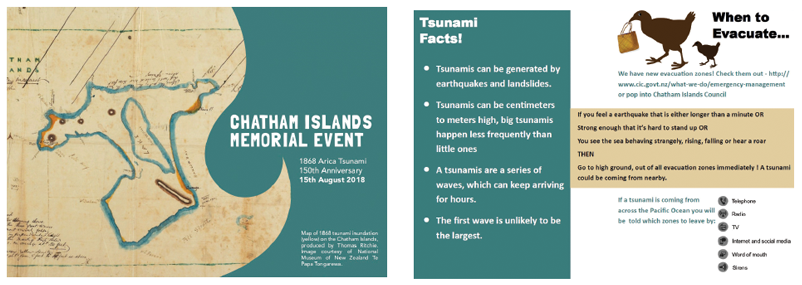
Figure 4: The postcard (front and back) with tsunami facts and evacuation messages. Image: Emily Campbell
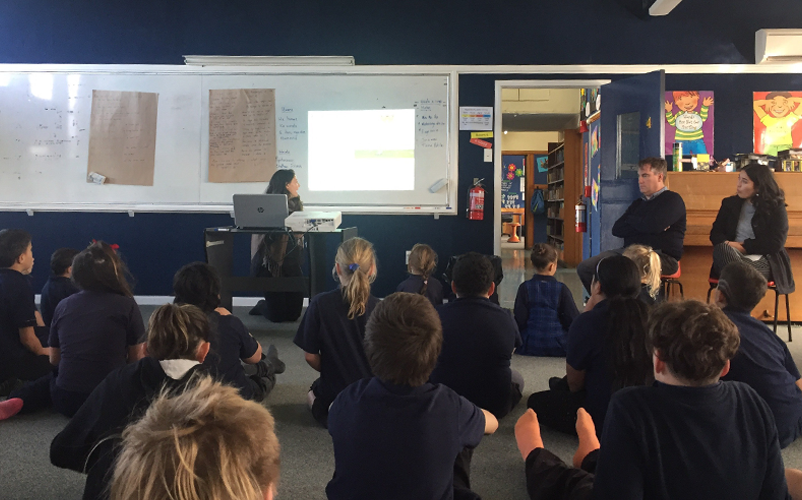
Stories were shared of the 1868 tsunami with Te One School students and teachers. Image: Lucy Kaiser
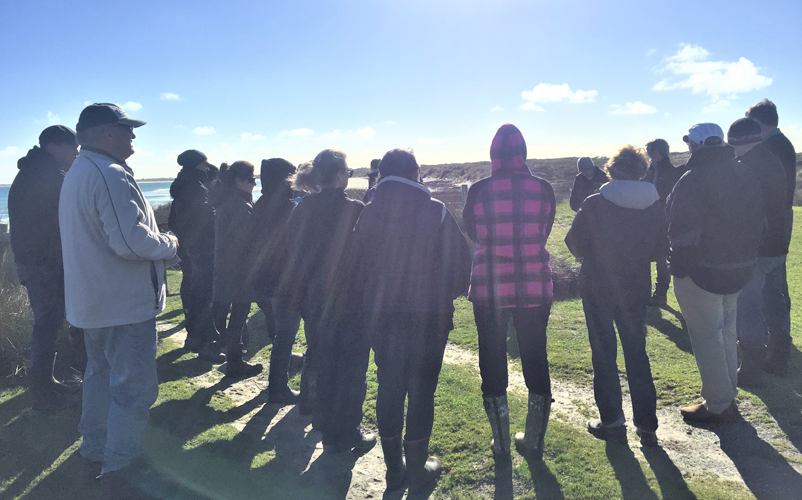
Members of the Chatham Island community gathered for a karakia and story sharing at Waitangi West. Image: Lucy Kaiser
Initially the memorial was scheduled for Wednesday 15 August, the day the tsunami struck (1:00 am Chatham Islands time), but it was rescheduled to Tuesday 14 August to accommodate a tangi14 and a teacher strike scheduled for the Wednesday. This allowed an acknowledgement of the moment the earthquake struck in Arica and to consider how the tsunami travelled across the Pacific Ocean.
Activities of the memorial included:
- gathering at the Emergency Operations Centre at start of the memorial event for a karakia to commence proceedings and introductory speeches
- karakia acknowledging people lost at Tupuangi and korero at Waitangi West Beach about the tsunami and the impacts
- a convoy of vehicles to the site with a stop at the moment the earthquake struck (10:15 am Chatham Islands time) to observe a minute of silence for those who lost their lives in the 1868 Arica earthquake and tsunami
- sharing a meal at the EOC followed by a presentation of recent tsunami research findings, newly developed tsunami evacuation zones and tsunami readiness information
- visiting Te One School for a presentation and tsunami-readiness activities that included playing a game to educate children about earthquakes causing tsunami and identifying their homes, and evacuation routes on the evacuation zone maps. Postcards with key information about tsunamis were distributed for them to take home to their families.
Three media releases were prepared by GNS Science, the National Science Challenge Resilience to Natures Challenges and eCoast, that described the 1868 tsunami and its impacts on the Chatham Islands and Banks Peninsula (Table 1). eCoast prepared animations of the tsunami propagating across the Pacific Ocean and how the tsunami affected various sites along the Aotearoa-New Zealand coast including Lyttelton Harbour and Sumner in Christchurch. A news story about the tsunami, with associated social media promotion, was written by GeoNet. The story described the tsunami and its effects along the New Zealand coastline, incorporating eCoast’s animations with a reminder for New Zealanders to know tsunami evacuation zones. A story was prepared for The Chatham Islander that detailed the effects of the 1868 tsunami and listed things Chatham Islanders could do to be ready for a future tsunami. Information was posted on the Chatham Islands Council website. Ian Simpson, CEO of GNS Science, sent letters to the New Zealand ambassadors of Chile and Peru sharing the plans for the event and sending condolences for the shared devastation of the 1868 tsunami. The media releases and stories were a collaborative effort to increase awareness of this fatal event and to improve preparedness for future tsunamis.
Discussion
This memorial event served as excellent outreach to promote tsunami awareness and preparedness. The anniversary was widely covered in the media through news articles, social media, magazines and newspapers (Table 1) and many Chatham Islanders attended the memorial event. This showed the appetite of people to commemorate disaster anniversaries and indicates an educative function of memorials to share messages of preparedness. With passing time, people who have not been directly affected by disasters benefit from the educative role of memorial events. Memorials must be co-designed with the community whose ancestors experienced the event and should be carried out in culturally appropriate ways respective of the local context.
Table 1: Press releases, news stories and animations about the anniversary memorial event.
|
Media Type |
Agency |
Link |
|
Media Release |
GNS Science |
www.gns.cri.nz/Home/News-and-Events/Media-Releases/Chathams-tsunami-anniversary |
|
National Science Challenge Resilience to Nature’s Challenges |
https://resiliencechallenge.nz/media-release-tsunami-preparedness-in-the-chatham-islands/ |
|
|
GeoNet |
www.geonet.org.nz/news/6QkxQCLs0E4A0QQqgKMQiC |
|
|
eCoast |
www.ecoast.co.nz/tsunami-of-august-1868/ www.youtube.com/playlist?list=PLiR2pNH9T8nRpbqUnwpYsDUWL_LPXSQ3X |
|
|
Chatham Islands Council |
www.cic.govt.nz/your-council/news-and-events/2018/150-years-ago-on-the-chatham-islands/ |
|
|
Chatham Islander Newspaper |
https://drive.google.com/file/d/0B1OcswQ6_z-OWWYweWZ4Yk5ZdHlhNGI1dFAzNXl0dTgxcFdn/view |
|
|
Online News Articles |
Māori Television |
www.maoritelevision.com/news/regional/150-years-chatham-islands-fatal-tsunami |
|
Newshub |
www.newshub.co.nz/home/new-zealand/2018/08/video-shows-impact-of-new-zealand-s-largest-tsunami-on-150th-anniversary.html |
|
|
NZ Herald |
www.nzherald.co.nz/nz/news/article.cfm?c_id=1&objectid=12106143 |
|
|
Scoop Sci-Tech Independent News |
www.scoop.co.nz/stories/SC1808/S00020/scientists-go-to-chathams-for-anniversary-of-deadly-tsunami.htm |
|
|
Stuff |
www.stuff.co.nz/science/106213804/Only-deadly-NZ-tsunami-on-record-hit-the-Chathams-150-years-ago |
|
|
GeoNet |
www.geonet.org.nz/news/6QkxQCLs0E4A0QQqgKMQiC |
|
|
Magazines |
Insurance Business Magazine |
www.insurancebusinessmag.com/nz/news/breaking-news/memorial-set-to-commemorate-nzs-only-deadly-tsunami-108748.aspx |
|
Natural Hazards Magazine (2017) |
https://www.naturalhazards.org.nz/NHRP/Publications/Natural-Hazards-Issues |
|
|
NZ Today Magazine |
www.stuff.co.nz/science/106213804/Only-deadly-NZ-tsunami-on-record-hit-the-Chathams-150-years-ago |
Approximately 30 Chatham Islanders, including Kaingaroa School, joined the commemoration on Tuesday morning. Te One School was included on the Tuesday afternoon. Approximately 100 Chatham Islanders (20 per cent of the resident population) were involved. Attendees sharing information to spouses, parents and siblings may have expanded this reach. The events were planned well and were led by local, well-known and trusted researchers with community connections and who collaborated with an iwi representative and Civil Defence Emergency Management staff. Although identifying direct descendants of the families involved was out of scope for this project, it is recognised that including descendants would be vital to memorial design and organisation processes for future events. Impromptu feedback from memorial participants (either at the end of the day or in the days following) indicated they learnt a lot and enjoyed the day. The authors perceive that the most important motive for participants attending was to educate the younger generation and perhaps also for cultural reasons to acknowledge and respect the deceased. Future memorial events should collect formal feedback from participants to understand:
- people’s motives for attending to help understand why commemoration is important and what form memorial events should take for particular communities or groups
- how participants responded to the memorial activities, the forms of information presented and how these enable resilience
- whether construction of permanent reminders or designated places for people to reflect and remember would assist in education and increased resilience.
Some of the memorial event team, left to right: Hamish Campbell, Lucy Kaiser, Kristie-Lee Thomas, Emily Campbell, Debbie King, Rana Solomon and David Johnston. Image: courtesy Kristie-Lee Thomas.
Conclusion
The 1868 Arica tsunami caused destruction on the Chatham Islands and across the coastline of Aotearoa-New Zealand. The 150th anniversary was an opportunity to raise awareness and community preparedness for future events. A coordinated memorial event and communication materials achieved outreach across parts of Aotearoa-New Zealand. The anniversary was widely covered in the media and many locals attended the memorial event. The good attendance suggested significant interest in the anniversary and the threats tsunamis pose to communities. A strength of the project was the involvement of a wide cross-section of the community, including school children. This increased the educative value of the commemoration. Anniversaries in the centuries following such significant events provide opportunities to raise awareness of past disasters, to share scientific findings and the lessons learnt during and since that time. The aim is to keep people informed of disaster risk reduction activities and encourage public action to improve preparedness for future events.



